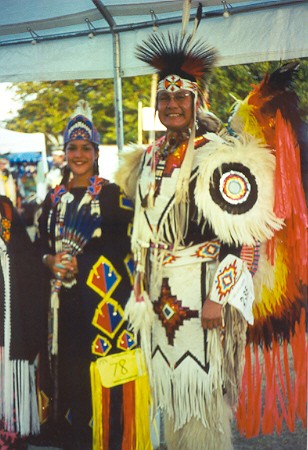|
|
Canku Ota |
|
|
(Many Paths) |
||
|
An Online Newsletter Celebrating Native America |
||
|
March 9, 2002 - Issue 56 |
||
|
|
||
|
Native American Dancers Thrill Students |
||
|
by James Beaty, Area
Editor McAlester
News and Capital & Democrat
|
||
|
credit: Oklahoma City Pow-Wow Club:
Head Lady Dancer Chrystal Yeahquo, Head Man Dancer Dennis Zotigh
|
 McAlester,
OK - People shouldn't believe everything they see or hear on television
- especially when it comes to Native Americans and their culture, according
to Dennis Zotigh, an Indian History research assistant with the Oklahoma
Historical Society. McAlester,
OK - People shouldn't believe everything they see or hear on television
- especially when it comes to Native Americans and their culture, according
to Dennis Zotigh, an Indian History research assistant with the Oklahoma
Historical Society.Zotigh and Jay Roberts were at Frink-Chambers School Tuesday to perform as part of the Great American Indian Dancers, a professional dance company that demonstrates some of the dances and music of the 500 Native American tribes in the United States. Students from the Choctaw Nation Head Start program, Tannehill Schools and Jones Academy joined Frink-Chambers students for the demonstrations. The dancers use stories, songs, music and dancing to help break down stereotypes and to give people a glimpse into Native American culture, according to Leslie Cates, Indian Education director at Frink-Chambers. Television, Zotigh said, usually misrepresents Indians and their culture. For instance, he said, the familiar four-beat tom-tom rhythm often used in western movies isn't used by any Indian tribe he knows of. "We've visited tribes in all 50 states and Canada and haven't found one that used that beat," he said. "Whoever put that drumbeat on television and the movies was not an Indian and didn't know much about Indian culture." Zotigh said another stereotype he often sees is the typical one where the Indian in the movies says "How!" as a greeting. In fact, he said, often when the dancers visit schools some student will walk up and say it to him. "Don't do that to an Indian," Zotigh told students attending the presentation. "He'll think you're making fun of him or disrespecting him. That's not something you want to do." As the students laughed and clapped, Zotigh and Roberts performed dances such as a Buffalo Dance of the Kiowa and Ponca tribes, the Men's Fancy War Dance as performed by modern Ponca dancers and the Eagle Dance of the Jemez Pueblo. The eagle is sacred to Indians, Zotigh said, since in many Indian religions the eagle acts as an intermediary between the Creator and the people. Many people don't believe Indians have sense of humor, Zotigh said, "but that's not true." As an example, he performed an Eskimo dance about a seal hunt that had students holding their sides and laughing. Many Indian songs don't contain actual words, he said. Instead, "they have what's called vocables." A vocable is a sound that, when put in proper order and sung at a proper pitch, has some meaning to the singer or listener. For example, Zotigh said, the "...fa la la la la ..." of "Deck the Halls" are not actual words, but they are easily recognizable sounds. The crowd in the school gymnasium had a big laugh as seven students attempted to do the Men's Fancy War Dance. Most actually did more of a rock 'n' roll-type dance than anything resembling the dance Roberts had demonstrated. The students then went into the audience, selected seven teachers and returned to the gymnasium floor to join Roberts in a Friendship Dance. The dancers closed the show with Zotigh performing a hoop dance of the Lakota tribe. He used his body and 10 hoops, each marked at four points to mark the circle of life - birth, childhood, adulthood and death - to make many different designs, including a man on horseback, a butterfly and a tornado. Zotigh finished the dance by forming the hoops into a large ball he pulled off his body over his head. The ball, he said, represented the world. "If I was to remove one of these hoops, it would all fall apart. It's the same with us. We are all part of the world." To close, Zotigh told students "Don't believe everything you see on television about Indians. Most of it is not true."
|
|
|
||
|
|
||
| Canku Ota is a free Newsletter celebrating Native America, its traditions and accomplishments . We do not provide subscriber or visitor names to anyone. Some articles presented in Canku Ota may contain copyright material. We have received appropriate permissions for republishing any articles. Material appearing here is distributed without profit or monetary gain to those who have expressed an interest. This is in accordance with Title 17 U.S.C. section 107. | ||
|
Canku Ota is a copyright © 2000, 2001, 2002 of Vicki Lockard and Paul Barry. |
||
|
|
|
|
|
The "Canku Ota - A Newsletter Celebrating Native America" web site and its design is the |
||
|
Copyright © 1999, 2000, 2001, 2002 of Paul C. Barry. |
||
|
All Rights Reserved. |
||

